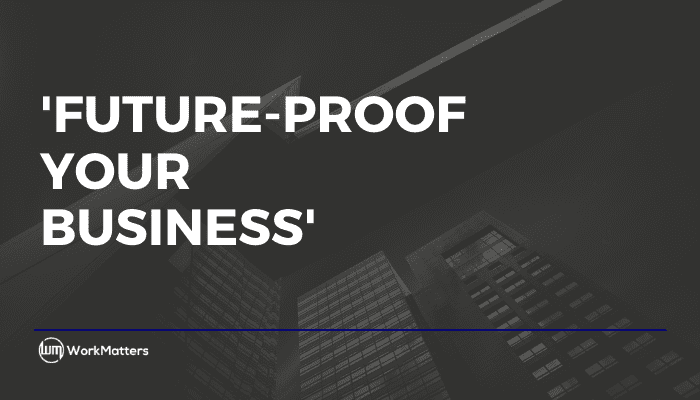As the ‘future of work’ debate continues, leaders can take three practical steps to future-proof their business.

Every week brings new stories about how the world of work is changing. Driven by forces such as advances in technology, global inter-connectedness and growing consumer expectations, new disruptions and innovations are appearing across virtually every business sector at a faster pace than ever before. But surely the world of work has always undergone constant change? Indeed, authors such as Charles Handy have been writing about this ‘new’ world for many years. Haven’t we, as humans, always adapted and continued on our way? The general consensus seems to be that the digitally empowered period we are now moving into, labelled loosely as ‘the future of work’, will undergo as fundamental a transformation as was experienced after the first Industrial Revolution. While robots, automation and millennials continue to grab the headlines, there is a fundamental shift in the very nature and structure of the world of work – a shift that business leaders and policy makers need to address before they get left behind. So what does the ‘future of work’ really mean for those leading organisations today?
Making sense of ‘the future of work’
Early adopters point to the need for organisations to be more strategically responsive and adaptable, more organisationally agile and also more comfortable in dealing with constant change. Organisations need to be responsive to fundamental changes in how work can now be delivered and organised, and to the emergence of a new employee and a multi-generational workforce with different (and sometimes not-so-different) expectations regarding work and the workplace. The ability to sense and respond to these challenges will be essential for long-term success. Commonly quoted essentials such as embracing new technology, dealing with continuous change and managing diversity are now accepted as ‘business as usual’ realities rather than anything new. But what should leaders do in the short-term to prepare for this new environment?
1. Set the right strategy
Given the wide range of topics, from artificial intelligence and digital technology to gig working and the changing workforce, it can be hard to make sense of the challenges and opportunities at an organisational level. Filtering all the hype from the real and material issues for your own situation is an important first step. To assist in that process, we use a scenario planning tool called SCOPE (Figure 1), which guides leaders through the main considerations specific to them and their business. Different organisational scenarios are tested for the future, from incremental change to major disruption. Standing back to consider key themes – from strategic flexibility to how the organisation’s culture, structure and processes are aligned and the type of workforce it needs for the future – this quick diagnostic helps executives explore the key questions and likely scenarios to help them get a handle on how their business is strategically placed for the future of work.
Organisational agility, for example, is a common theme that emerges from any review of strategy in the context of the future of work. Agility is well-established as a critical organisational competency that has helped organisations adapt to complex and rapidly changing business environments. For high-profile cases, just look at what Netflix and Amazon have done with their business models over the last 10 years. The compelling argument is that if business leaders can improve an organisation’s agility and build it into the organisational culture, structure and processes, they will have gone a long way in preparing their organisation for future challenges and opportunities.
2. Evolve your leadership style
It may sound obvious, but reflecting on the role and appropriate approach of leaders is also critical in helping the wider organisation thrive in the future of work. Writers such as Lurie and Fisk suggest that the digital economy requires a new kind of leader from before – one who can lead people in a direction that involves an increasingly diverse set of customers, employees and stakeholders. The outlook of digital leaders must also reflect the characteristics of their business environment (i.e. open, fast-paced, connected, non-linear, virtual and technology enabled). These writers and others contend, for example, that organisational leaders must develop agility as a core leadership capability so that they can respond effectively and calmly to the uncertainty and ambiguity of the modern marketplace. As Martin Goldsmith, author of What Got You Here Won’t Get You There, puts it: “Leadership agility is probably the most important competency for leaders to have in today’s rapidly changing world”. But what is an agile leader? Most models of leadership and leadership development today point to a shift in emphasis from traditional ‘command-and-control’ leadership styles to more transformational, ‘servant-based’ and agile leadership approaches.
In their book, Leadership Agility, William Joiner and Stephen Josephs define the natural and progressive development stages of the ‘agile leader’. From the traditional, tactical and problem-solving orientation of the “expert leader” to the more strategic and outcome-oriented “achiever leader” and then the more visionary and facilitative/empowering “catalyst leader”, Joiner and Josephs describe the practical skills of progressively leading in a more agile way. This helps to call out typical leadership development stages through the lens and language of modern agile principles and practices. Self-awareness and clarity of language and behaviour is helpful for any organisation seeking to be more deliberate and mindful in developing such skills and the working culture associated with organisational agility.
These future of work nuances required for leadership today, combined with what we already know about the more age-old and enduring qualities of simply being a good leader of people, will help leaders thrive in the new landscape and will also allow others in their care to do the same.
3. Build your best team
Armed with a sense of the strategic direction required to face the future of work and being aware of the leadership approach required, leaders should also look at who they hire, promote and keep within their future organisation. No leader can succeed alone, so having the right talent at all levels is a critical theme for leaders as their organisations evolve and grow.
New business and organisation models challenge many of our assumptions regarding traditional talent strategy and HR management. Many aspects of talent management will themselves require disruption and new thinking. For example, if an organisation is to be re-configured to take advantage of the business and cost benefits of a ‘blended’ mix of suppliers, outsourcing partners, free agents, automation and a core, full-time workforce, it follows that a new work design and workforce planning strategy will be needed to map out the organisation’s short-term and long-term talent needs. Indeed, the management of the non-core workforce will become a highly strategic function and consideration must be given to how the different parts of the organisation will work together to deliver optimum service to the customer.
Once the work design and workforce planning aspects are worked through, the rest of the talent life-cycle processes need to kick in and align. For example, recruiting for the right skills also needs to account for likely and possible changes in skills requirements further down the line. Therefore, attracting people with the right attitude and a learning mindset could arguably be as important as their immediate skills. Training and development will need to be continuous and provided through a mix of mobile, online, on-the-job and formal methods that align with changing business needs as well as the different learning styles of a modern workforce on the move. Rewards will be more flexed and individual, with a “consumer standard” employment experience demanded by different generations of employees. Even how we exit employees is changing, with employers seeing their alumni network as a talent pool for the future as well as important social advocates for their organisation when they leave. Meanwhile, the physical (and virtual) workplace is changing to accommodate new ways of engaging staff working and collaboration. Central to this new talent management story is a clear picture of what the organisation’s desired culture must be. There is a risk that some employers will promise the earth to attract sought-after employees only to find that they cannot deliver on their promises as new work models and skill requirements change the employment prospects of employees and their jobs over time. These new talent management realities will present both challenges and opportunities. We therefore need to re-think what we demand from our leaders and front-line managers, and what qualities they need to succeed. These qualities are possibly quite different to what organisations have hired and trained for in the past.
Where do we go from here?
We may not have all the details about what our organisations will look like tomorrow, but the one thing we can do today is basic scenario planning that considers different prospects for our own organisations ranging from incremental change to radical disruption. We can then set about designing a talent management strategy that puts the right leaders and people in place to deal with the inevitable changes as they continue to emerge and develop.








